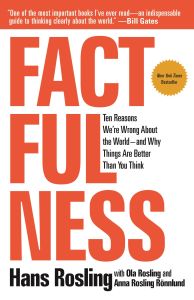 In a perfect world, journalists would always present the news in a completely accurate way, and they’d give plenty of relevant context to make it even more impactful. But, unfortunately, we live in the real world, where journalists are in the business of attracting readers, and readers love things to be both super simple and full of drama. As a result, our worldview has become skewed — a poor representation of what the world is really like.
In a perfect world, journalists would always present the news in a completely accurate way, and they’d give plenty of relevant context to make it even more impactful. But, unfortunately, we live in the real world, where journalists are in the business of attracting readers, and readers love things to be both super simple and full of drama. As a result, our worldview has become skewed — a poor representation of what the world is really like.
At the heart of our messed up worldview is the belief that people around the planet are worse off than they were before. But this couldn’t be further from the truth. In fact, there’s far less poverty than ever before, people everywhere are living longer and less of the world is being run by sexist and oppressive patriarchies.
This book helps us understand just how much progress has been made, and how we all can learn to overcome the negatives to see our world in a positive, accurate light.
Here are some interesting facts I picked up from the book:
1) In 1800, 85 percent of the world lived in extreme poverty; today, that percentage is down to 9!
2) According to the UN forecasters, the world population will flatten out between 2060 and 2100. Because hundreds of years ago, the average mother gave birth to around 6 children. Now, the average mother has 2.5 kids. So really we shouldn’t be worried about never-ending population growth.
3) If you read that 4 million babies died last year, the size of that number could lead you to believe that we live in terrible times. However, if you look up how many babies died in 1950, and see that the number is 14.4 million, you get a much more accurate understanding of the times we live in.
4) Of the ten fastest growing economies in 2016, nine of the countries are not very democratic. So don’t think that only democracy can lead to economic growth; the reality of the current global economy proves otherwise.
5) Take our fear of violence. We are exposed to a greater number of news reports on violence than ever before, so we think there is more of it. But the real numbers show that crime is down. In the United States alone, 14.5 million crimes were reported in 1990. In 2016, that number was down to 9.5 million. This is the trend in most countries worldwide.
The facts tell us that the world we live in today is a much better place today. Yet, we do worry. This is because of our fear and size instincts.
The reason for our fear instinct is rather self-explanatory – being afraid can keep you safe from threats. Our ancestors developed this instinct in more dangerous times when humans were at risk from saber-toothed tigers and rival tribes. As there are no longer as many immediate threats, we now tend to misplace our fear, worrying about threats that don’t really exist. And our size instinct leads us to overestimate the dangers that our fear instinct creates for us.
Net Net, in just about every single measurable category, life is better now than it was 200, 100 or even 50 years ago. People are living longer, there’s more access to health care and education and there’s far less poverty. Recognizing this takes looking beyond your one news channel and accessing the real facts and putting them into context.
FACTFULNESS by Hans Rosling is a must-read. I strongly recommend it.